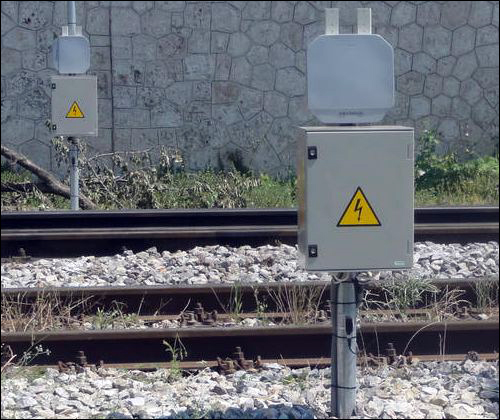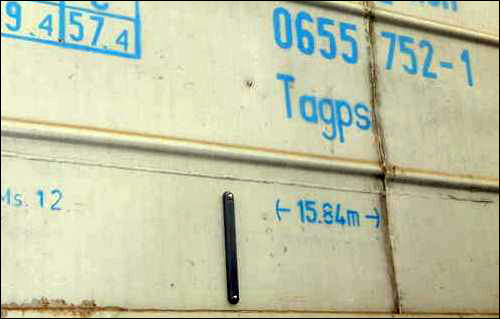TrainOSE, Greece’s rail service provider, is employing a radio frequency identification-based solution to track freight cars. While the company is still reviewing the results since the system was taken live last year, it has already determined that the technology is reducing rental costs for cars that should be returned to third-party owners.
Trinity Systems provided the passive EPC Gen 2 ultrahigh-frequency (UHF) RFID tags that were attached to railcars, as well as the RFID readers that were installed at key locations along the tracks. The company also installed and integrated the system with TrainOSE’s software and trained TrainOSE’s personnel in its use. The solution employs RFID to identify passing cars, determine dwell times at each station and calculate transit times between stations. The agency hopes that knowing this information will help it to better manage logistics scheduling.
TrainOSE is the sole provider of passenger rail service in Greece and the major operator for freight trains throughout that country. The company operates its own domestic railcars (known as wagons), as well as those that it rents from providers in other nations that move freight around or through Greece. The Hellenic Railways Organization (OSE), TrainOSE’s former parent company, owns the tracks, rail stations and domestic rolling stock.
In many cases, third-party railcars loaded with freight arrive in Greece from such places as Germany or Austria. Europe’s International Wagon Regulations (RIV) limit the number of days that those railcars can remain in Greece, requiring TrainOSE to pay a daily rental fee once that time has been exceeded, until the cars are returned. TrainOSE often uses such foreign wagons to deliver freight—for instance, a wagon from Austria is emptied, reloaded with goods from a Greek company, and rerouted perhaps to Austria or another location.
Such a system can be highly complex and difficult to manage for TrainOSE and other providers. For example, if a wagon is not returned within the allotted span of time, TrainOSE must identify where that wagon is located and determine why it is delayed. The company typically tracked the locations and statuses of wagons via written reports faxed to dispatchers and TrainOSE managers as those wagons arrived at each station.
The Greek railroad operator wanted to improve the visibility of wagons—both rented and its own—according to Aris Kotsas, the director of TrainOSE’s rolling stock directorate. Therefore, in 2014, it began seeking a technology-based solution as part of a wide-ranging project that TrainOSE had under way to modernize its data management. “TrainOSE, for the past few years, has invested in developing its own online platform for managing all operations,” Kotsas says. “Automated asset tracking of the rolling stock using RFID technology was one of the last parts that were incorporated to our online freight-management platform.”
“This was a complicated and challenging project,” says Theodore Vasiliadis, Trinity Systems’ co-founder and CEO. The railway company wanted to use RFID to track the wagons initially at 40 sites, such as in rail yards, maintenance facilities and stations. At some locations, the readers would need to be installed in clusters (multiple readers in a small area, each sending data to a gateway device), while at others, they would be at very remote locations, making the transmission of data to the server challenging.
Trinity Systems and TrainOSE opted to attach Confidex Survivor tags to approximately 100 wagons, near the serial number painted on the side of each car, with each wagon’s ID number encoded to the tag’s memory. They started with a pilot deployment, during which they installed six Kathrein RFID RRU4-ETL-E6 readers, with Kathrein WIRA-70 antennas, along tracks in the railway network’s northern section. Then, Vasiliadis says, after running the pilot project for six months, the companies expanded the deployment last summer to a total of 20 Kathrein readers at trackside, “just outside the [clearance] safety zone of each track.” While TrainOSE acquired 40 such readers, it found that it currently needs only 20 to provide the data required. The other 20 will be installed as necessary to enhance the entire system’s tracking resolution.
Passenger cars pass the readers at a maximum speed of 140 kilometers per hour (87 miles per hour), Vasiliadis reports, and the system has been tested on passenger trains. Freight trains have a maximum speed of 100 kilometers per hour (62 miles per hour). Although the companies tested the tags on passenger trains to ascertain the speed at which tags could read, the tagging is intended only for freight cars. The tags could be read well at high speeds, Vasiliadis says, noting that the read range is about 7 meters (23 feet).
In addition to attaching permanent tags to its domestic fleet of freight cars (that process is still under way at its maintenance facility), TrainOSE is also attaching temporary tags to the third-party wagons (from foreign operators) that enter through its northern border crossing, using an ATID AT870 handheld reader to capture each tag’s ID number and link it to the wagon’s serial number and owner in TrainOSE’s software.

As each tagged railcar passes by, the reader captures its tag ID number and forwards that information to TrainOSE’s back-end software, which associates that particular wagon with the reader’s location. Some readers are cabled directly to the server. In urban areas containing clusters of readers, the devices are connected to Wi-Fi bridges that forward the collected data to a Wi-Fi gateway that, in turn, is cabled to the server. In one case, the local phone company is providing a connection from the reader to the server via a landline, so that TrainOSE need not use a cellular connection.
The software not only records the wagons’ locations, but also determines if an unexpected action takes place. If, for instance, the software detects that a wagon has arrived at an incorrect location, or is ahead or behind schedule, it can issue an alert to authorized managers so that they can then investigate and remedy the problem through dispatch.
Initially, Vasiliadis says, Trinity Systems and TrainOSE needed to ensure that the technology was sufficiently rugged for the conditions to which they would be exposed. The tags can typically be exposed to engine oil, dirt, jets of water and precipitation. Both readers and tags must be able to sustain extreme weather conditions, with temperatures ranging from -15 degrees to more than +40 degrees Celsius (5 degrees to 104 degrees Fahrenheit) during the heat of summer.
“The system is working very well as we are gradually continuing to tag our domestic rolling stock,” says Michalis Brakis, the supervisor of TrainOSE’s freight rolling stock department. “So far, the results we’re getting meet our initial expectations. In addition to optimizing our operations and helping us to provide better value-added services to our customers, real-time visibility of rolling-stock significantly helps to reduce annual RIV fees.”
A total of 2,500 freight wagons have been permanently tagged with UHF RFID tags, while all third-party railcars entering the national railway network via Greece’s northern border (representing about 90 percent of foreign train access) are being temporarily tagged. Instead of mounting a single tag near each wagon’s serial number, as it did during the pilot deployment, the company has been applying two tags—one on each side of every wagon—in order to ensure that each car can be easily identified regardless of on which side of the track the reader is situated.


